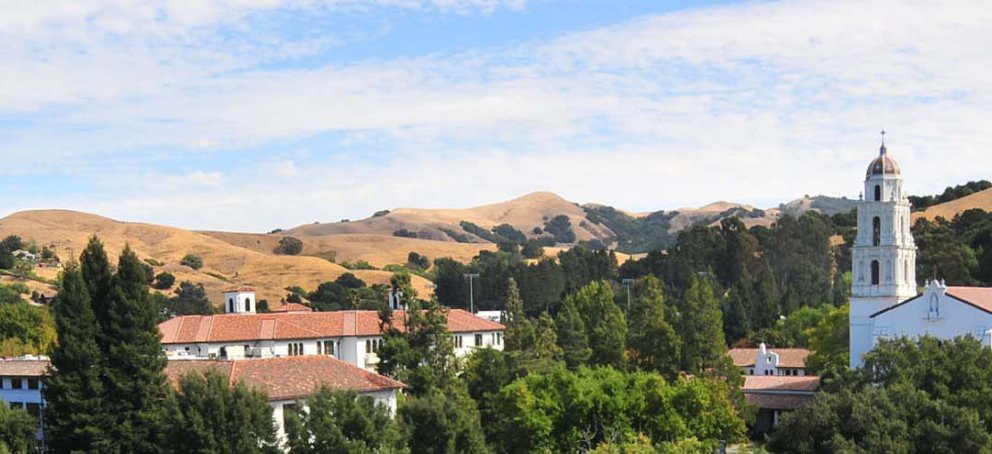History of the Chapel
Taken from A Guide to the History of the Saint Mary's College Campus, by Br. L. Raphael. Moraga, 2000.
Dedicated in 1928 to "Mary, of whom was born Jesus", the chapel is the focal point of the campus in several respects. Originally, in 1863, Archbishop Alemany named the college (as well as Saint Mary's Hospital and his cathedral) for Mary under her title the Immaculate Conception, a dogma proclaimed in 1854. The patronal feast is thus 8 December, as it was celebrated at the College for years. In 1930, the east window, installed high in the chancel, represented instead the Assumption, due to some unexplained rearrangement. The confusion led people to take the patronal day as the 15th of August (when, of course, no students are present on campus). Oddly enough a parallel switch occurred back in San Francisco: when old Saint Mary's on California Street was abandoned in 1891, the new cathedral on Van Ness was dedicated to the Assumption of Mary.
The chapel bell tower is modeled after that of the Cathedral of Cuernavaca (see BELLS), while the 55-foot-high nave is a scaled-down copy of the Cathedral of Monreale in Sicily. The chapel and indeed the entire campus are set in Mission Renaissance style as designed by John J Donovan of Oakland (see MORAGA). The reredos, behind the high altar, is typical of this grand style. The new building was dedicated by Edward J Hanna, Archbishop of San Francisco, on 5 August 1928.
The Loma Prieta earthquake provided a strong argument for strengthening the structure. In that quake, with the Brothers at vespers in the side chapel, John the Baptist took a header off the reredos, damaging the statue and making a dent in the stone altar steps. By 1998, some major donors and many, many smaller donations made possible a complete overhaul of the nave. A traditional spanish tile floor replaced a mustard-yellow shag carpet from a wrong-headed redoing of the interior during the 70s, the 1928 pews were refinished in Southern California, and the heads of the aisles pushed through to the side chapels. The old confessional recesses were converted into frames for art-pieces and the choir loft redone to allow the installation of the new Simon ORGAN. Only the rather inappropriate lighting fixtures in the nave remain from the 70s.
In the ARCADE outside, over the 3 entrance doors, are plaques of Mary and Joseph with Jesus in the centre, created by local artist Charles Tilden. The entrance vestibule, beneath the loft, contains a xvii-century Flemish Assumption donated by Richard Gump of the San Francisco family. On the right is the memorial wall listing the benefactors of the chapel.
Just inside the central door to the nave is the new baptismal font. In the nave itself, in the north aisle, a niche is devoted to a stained glass of Our Lady of Guadalupe, the patroness of the Americas. The door leads to the north PATIO. Continuing on the right, the arched niche in the north aisle at the front holds a Madonna and Child carved in wood about 1450, a gift of Gertrude Shaefer-Simmern, and considered the patroness of the College. At the end is the Brothers' (or La Salle) chapel, where the original 1928 tabernacle, flanked by 2 stone angels from the old altar rail, is now located. Here as well are a sixteenth-century Madonna holding grapes and, hanging above the tabernacle, a fifteenth-century Italian crucifix of leather and wood. A large painting of the Virgin and Angels from the school of El Greco is on the wall. In the double niche is a diptych of 2 nuns at prayer, overseen by Francis and Catherine.
The main altar is in memory of Marie Doran and of Fr Edward Doran, Class of 1879. The ornate reredos features the Immaculate Conception at the top, Joseph on the left, John the Baptist on the right, and the Virgin and John the Divine at the foot of the central cross. The east window is of the Assumption.
In the south aisle are shrines to Saint de La Salle, the Founder of the Brothers and Patron of all teachers, and a bronze statue of Saint Anne, the mother of the Virgin, created by Bruce Wolfe. Another door leads out to the south patio. At the head of the south aisle is the Mystical Marriage of Catherine of Siena, a xix-century mosaic by Mulusandi.
Behind is the Carmelite chapel set off by the 2 -story wooden grille, once used by the cloistered Carmelite sisters living in what became later BENILDE Hall. A list of their community may be found on the wall. Here also is a xvii-century Franconian crucifix. The wooden carving of the 5 holy Brothers on the back wall of this chapel was done by sculptress Rosa Estabanez. At 1 time, sick students confined to the infirmary were able to attend mass in an upper room behind the grille at the right side of the high altar.
The stained glass was shipped from Oidtman in Aachen and installed in 1930 (making the chapel considerably darker). High in the clerestory the life and titles of Mary are represented, in the aisles the life of Saint de La Salle, the Founder, and over the main altar the roses in the empty tomb mark the Assumption of Mary. Several smaller modern windows in the side-chapels, including 3 of Christian Brothers: Saints Miguel of Ecuador, Benilde and de La Salle, were donated in the 80s by Father Edmund Moss, Class of 1932.
The chancel of the Moraga Chapel in its original state, 1 afternoon before 1931. The east window has yet to be installed. The curtain on the left was drawn to close the north transcept, the Brothers' chapel. The altar rail was removed in the 70s but the angels — and the tabernacle– were returned in 1999.
Please submit any corrections or additions to:
Br. L. Raphael, FSC
rpatton@stmarys-ca.edu
PO Box 5150 SMC
Moraga CA 94575
